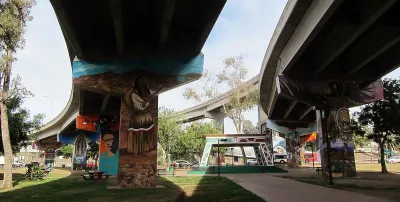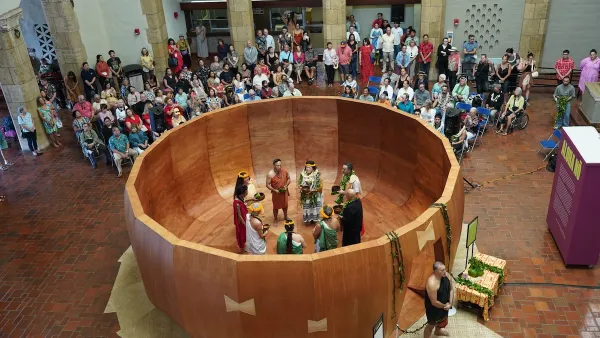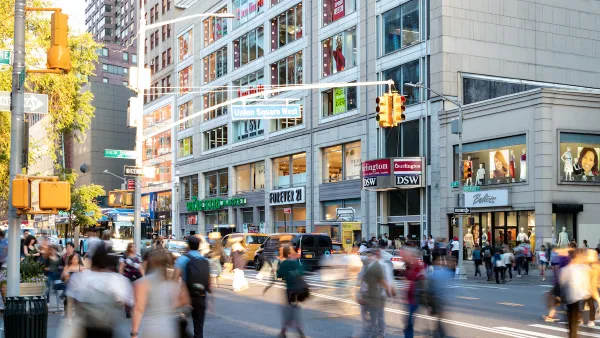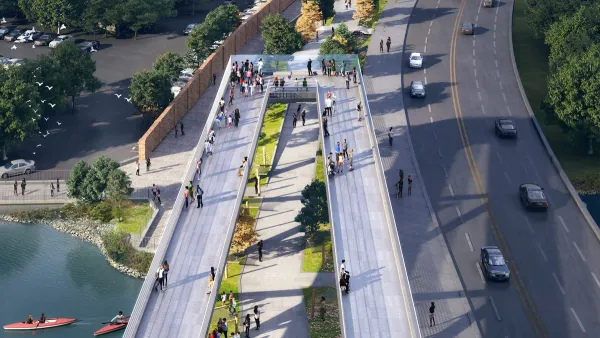How bringing local artists into the development process can foster more vibrant, equitable neighborhoods.

In many urban environments, exclusivity and exclusion prevail, pushing many citizens to the margins. Art stands as a universal and accessible medium that bridges cultural divides. Armed with their talents and tools, artists can create works that resonate with their communities, reflecting their heritage and struggles. Museums with free or reduced-fee entry, murals, street art, public libraries, and media consumption make art a powerful tool for inclusivity.
Real estate increasingly feels out of reach, making inclusive development a challenge. The shiniest, most artfully composed, amenity-rich buildings usually come with dizzyingly high price tags, and even modest homes are expensive. Nationwide, the median sale price for an existing home is $394,300, according to the National Association of Realtors, while the highest interest rates in 23 years render ownership unaffordable. Renters do not escape the squeeze. Average rent costs the average household a record 30 percent of its monthly income, according to Moody’s Analytics. Low-income families face even more severe rent burdens.
Art and real estate may seem diametrically opposed, the former being open to the masses, the latter walled off for the fortunate few. Yet this dichotomy presents an urban planning opportunity. Art and real estate are both acts of creation, constructing something new where there was once only empty space or the faint trace of an idea. Development has a long record of benefitting wealthy neighborhoods while bypassing underserved communities. By following the inclusive path of creative endeavors, real estate development can heighten a community’s vibrancy and economic viability. Harnessing art and artists can crack open the gates of real estate.
Creatives drive collaboration, culture, and inclusion
Integrating artists’ perspectives in planning will start to break down barriers to economic growth and sustainable development. Amplifying the role of artists in development can make real estate more diverse, equitable, and accessible. Creatives make three dynamic contributions to inclusive development:
- Creatives are well-versed in collaboration. Artists often pool their resources, ideas, and unique skill sets to create new and interesting work. Even when they aren’t directly collaborating, artists are influenced by each other’s work. Creatives constantly borrow from one another. Nothing is made in a vacuum. As Salvador Dalí said, “Those who do not want to imitate anything, produce nothing.”
- Typically, artists aren’t just in conversation with other artists—they are creating work that reflects their communities. Planners and developers can adopt this spirit of collaboration and conversation in their community engagement. A more inclusive engagement process gives residents agency, ensures that new developments reflect community needs, and promotes greater community buy-in. Developers can team up with local creatives to establish productive relationships in the community.
- Artists are often fluent in a community’s cultural legacy. This is particularly true in communities of color, which have historically faced racism, second-class citizen status, and erasure. As a means of self- and community expression, art is an instrument to share social and political messages supporting equity and a vehicle to envision a better future.
- Partnering with artists can help developers preserve and honor a neighborhood’s cultural heritage and inspire community pride. Strategies include commissioning local creatives to produce public art that celebrates the community’s history and customs and supporting the creation of artist studios and galleries to promote community members’ work. By inviting creatives to help design public spaces such as parks, plazas, and playgrounds, the built environment will be more inviting, engaging, sustainable, and culturally specific.
- Creatives take risks and lean into experimentation. Some of the most memorable artists are bold. They seek fresh means of expression and don’t shy away from risky concepts or challenging mediums. Take, for example, contemporary artist Kara Walker, who in 2014 famously debuted a massive sugar-coated sculpture of a sphinx with the head of a mammy figure. The 35-foot-high, 75-foot-long sculpture challenged viewers to consider racism, sexism, Black womanhood, and the exploitation and dehumanization of workers, from enslaved people in cane fields to factory laborers.
Real estate developers would be wise to borrow from artists’ risk-taking ethos. Planners can give them incentives to invest in undervalued and under-resourced Black neighborhoods. Such groundbreaking projects bring participants a higher potential for both economic and cultural success. In planning new projects, developers should consider bringing creatives to the table early and often. Art encourages diverse perspectives, and artists are trained in multiple ways of seeing. Creatives can enrich developments with their imaginativeness and find ways to incorporate ingenious designs and meaningful diversity.
Artists tap into the power of connection
Art is about expression, but the most effective work fosters human connection. Creatives understand that the best art helps us build empathy and deepen identity, allowing us to better see others and see ourselves. By making more space for the creative class in urban planning, developers can build cities that inspire a sense of belonging and provide everyone with a place to call home.
Wells Davis is the chief strategy officer for the Woodlawn Central development on Chicago’s South Side.

Analysis: Cybertruck Fatality Rate Far Exceeds That of Ford Pinto
The Tesla Cybertruck was recalled seven times last year.

National Parks Layoffs Will Cause Communities to Lose Billions
Thousands of essential park workers were laid off this week, just before the busy spring break season.

Retro-silient?: America’s First “Eco-burb,” The Woodlands Turns 50
A master-planned community north of Houston offers lessons on green infrastructure and resilient design, but falls short of its founder’s lofty affordability and walkability goals.

Test News Post 1
This is a summary

Analysis: Cybertruck Fatality Rate Far Exceeds That of Ford Pinto
The Tesla Cybertruck was recalled seven times last year.

Test News Headline 46
Test for the image on the front page.
Urban Design for Planners 1: Software Tools
This six-course series explores essential urban design concepts using open source software and equips planners with the tools they need to participate fully in the urban design process.
Planning for Universal Design
Learn the tools for implementing Universal Design in planning regulations.
EMC Planning Group, Inc.
Planetizen
Planetizen
Mpact (formerly Rail~Volution)
Great Falls Development Authority, Inc.
HUDs Office of Policy Development and Research
NYU Wagner Graduate School of Public Service




























